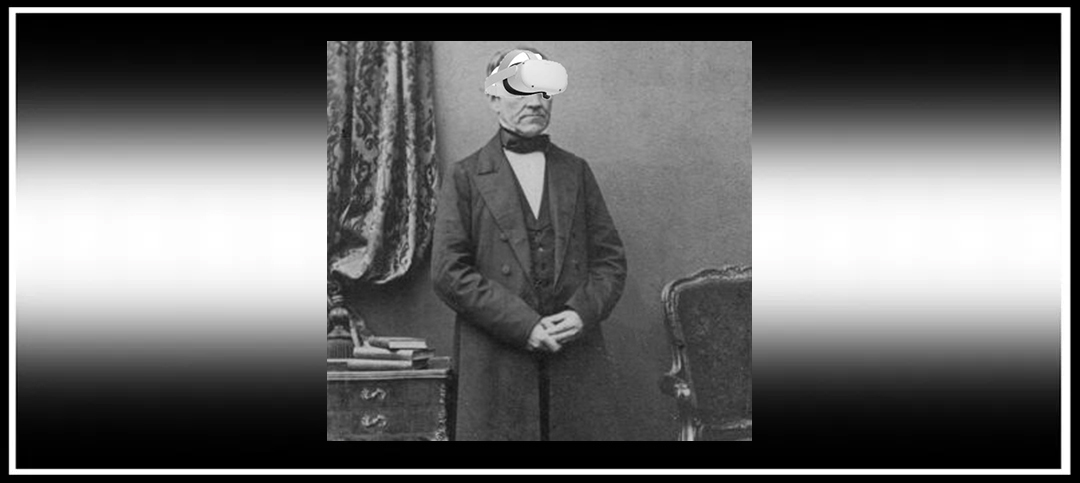I thought to honour the father of virtual reality, Sir Charles Wheatstone, on the 150th anniversary of his death, I’d share a post about how to view almost any stereoscopic image in a Meta Quest VR headset, using an app I’ve been enjoying for the past year, and am really impressed with, ImmerGallery. I thought this guide would be useful for those in the heritage sector looking for ways to share and engage people with their collections, as well for as collectors and 3-D enthusiasts.
ImmerGallery is an app which allows stereoscopic images, whether modern or old, to be displayed in Meta Quest 2, Meta Quest Pro, Meta Quest 3, and Meta Quest 3S VR headsets, and soon SteamVR. It is available in the Meta Store as a limited free demo, or the full version for a one-off cost; in the UK at £23.99, and in the USA at $29.99. I will state here I found this app by myself and am in no way affiliated with the company who developed it, I’m just very enthusiastic and impressed with its capabilities and possibilities. For more detailed information about the app, its developments, their company, other products, or if you have any questions, please visit the ImmerVR website.
ImmerVR give a list of compatible cameras and formats for ImmerGallery on their website. I’ve just picked a few out which I thought might interest stereoscopic photographers, including:
- Acer SpatialLabs Eyes Camera (ASEC-1)
- Apple Spatial Photos (.heic) Apple Spatial Videos (1080p)
- Fujifilm FinePix Real 3D
- Kandao QooCam EGO
- Panasonic Lumix DMC-3D1
- Samsung Galaxy Phones with “3D Capture”
- XREAL Beam Pro
- All 2D cameras, smartphones, tablet or 2D drawings (.jpg) – as it can also convert mono images to stereoscopic 3-D.
Compatible file formats:
- .jpg / .jpeg
- .png
- .mpo
- .webp
- .bmp
- .heic (2D and 3D spatial)
- .tiff
- .gif (static)
- .jps (3D low field-of-view side-by-side stereo jpg)
The .jpg or .tiff formats can be a important ones, as it means you can also scan historic stereoscopic photographs, use software to digitally clean and align them, remove as much ‘mount’ as possible, and then put them in the VR headset’s storage to view in the ImmerGallery in stereoscopic 3-D. There is even free desktop software to help you prepare the scanned stereoscopic photographs in this way, please see this post on StereoPhoto Maker for a step-by-step guide to using it. The only disclaimer I’ll add to this is to be careful if you’re flipping through historic and modern stereos in the headset. Often, the depth switch from hyper to not-so hyper 3-D images causes a roller coaster in your brain and stomach.
Once you’ve got your images files on your PC or Mac, you can then transfer them to your Meta headset to the ImmerGallery’s ‘Local’ folder.
I use a Mac, and I use Android file transfer to do this. I connect the Meta Quest to the Mac by USB, switch on the headset, click on ‘USB detected – allow connected device to access files’, open the Android File Transfer app on the Mac, and drop the files from the Mac to the ‘Pictures’ album in the headset. Now they’re ready to open in the ImmerGallery app.


Here’s another helpful video from ImmerVR to show how to do this, and for PCs:
Now, hopefully, you will be able to enjoy your stereoscopic images in VR with ImmerGallery!
Enjoy.

Copyright © The Stereoscopy Blog. All rights reserved.
News
Berita Olahraga
News
Berita Terkini
Berita Terbaru
Berita Teknologi
Seputar Teknologi
Drama Korea
Resep Masakan
Pendidikan
Berita Terbaru
Berita Terbaru
Berita Terbaru

